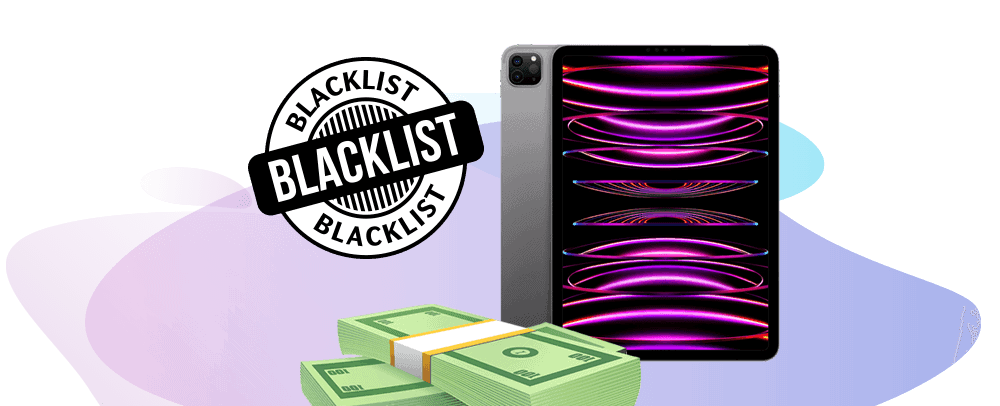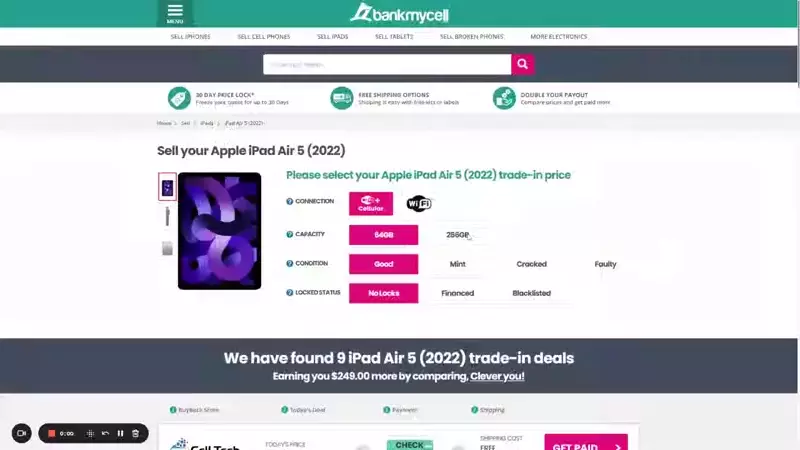Sell a Blacklisted iPad with Bad ESN or IMEI (Any Carrier)
- Do you think you have a blacklisted iPad? In this article, you’ll learn what it means to have a blacklisted iPad.
- Discover what causes a blacklisted iPad and how to remove it on the blacklist.
- Learn your options for selling a blacklisted iPad, from selling it on marketplaces and buyback companies. Compare Quotes Now
Today’s Top Price for Blacklisted iPad:
$650.00
BankMyCell compares over 100,000+ quotes and customer reviews from 20+ trusted buyback stores every 15 minutes via our data feeds, making us America’s #1 time-saving trade-in supermarket.


You Can Sell Your Blacklisted iPad Today!
Where to Sell Blacklisted iPads?
To recover some of your blacklisted iPads value, sell it to buyback stores found on BankMyCell. To ensure a smooth transaction, be clear about the fact that the device is blacklisted and provide accurate details about its condition. This will help make the selling process easy and problem-free.
To sell a blacklisted iPad follow these steps:
- Find your device and select the “Blacklisted” status
- Choose storage and condition.
- Select a store, ship for free, and get paid.
What is a Blacklisted iPad?
An iPad can be blacklisted for any of the following reasons:
- Reported as lost or stolen.
- Associated with fraudulent activity.
- Unauthorized modifications.
- Unpaid remaining balance and violations on your carrier contract.
When an iPad is blacklisted, its unique identification number (IMEI), is added to a database of devices that should not be allowed to connect to cellular networks. This status restricts its use on cellular networks and may limit certain features. It’s crucial to check a device’s status before purchasing to avoid potential issues.
How to Check Blacklisted Status
Before purchasing or selling an iPad you should check if the device is blacklisted. First find your iPads IMEI number:
- Flip the device over and find the engraved text on the back
- The IMEI is written in this section
- Input the iPad’s IMEI number in the search bar
- Click Check
- Review feedback verifying if the iPad has been reported lost or stolen or has an outstanding balance with the carrier.
How to Resolve Blacklisting Status
To maximize the resale value of your iPad, it’s recommended to unlock a blacklisted device before selling. If the iPad is blacklisted due to outstanding payments, it’s advisable to try resolving the finance blacklist before selling to optimize its market value.
Follow these steps to unlock your iPad:
- Reach out to your carrier (AT&T, Verizon, Sprint, or T-Mobile) to understand the reason for the blacklisting. Resolve any outstanding payments on your account to eliminate the blacklist.
- Explore third-party blacklist removal services like IMEI Authority, DirectUnlocks, or ExpressUnlocks. Note that these services come at a cost and don’t guarantee removal without proper proof of ownership.
- If the device was blacklisted by a previous owner reporting it as lost or stolen, the carrier may be unable to unlock it. In such cases, contact the previous owner to address the issue.
If you cannot remove the blacklist status from your iPad, you can still proceed with selling the device.
What Does It Mean If My iPad Is Blacklisted?
An iPad gets blacklisted if it has been reported lost or stolen by its previous owner. Basically, a blacklisted iPad cannot connect to cell towers providing CDMA networks and GSM networks. This means you are not capable of making calls and sending messages, because it couldn’t connect to any cellular network. Surfing online using cellular data won’t also be possible.
What Causes Bad IMEI/ESN on an iPad?
The IMEI (International Mobile Equipment Identity) and ESN (Electronic Serial Number) are unique numbers that uniquely identify your iPad. If you get a bad ESN or IMEI, that means your current carrier is has blacklisted your iPad and no longer usable.
Here are some possible reasons why an iPad gets bad ESN/IMEI:
Carrier issues:
If you have an unpaid remaining balance and violations on your contract under carriers like AT&T, T-Mobile, or Verizon, your mobile network may blacklist your iPad. So if you owe money to your carrier, simply pay your due and your iPad will be unblacklisted most likely on the same day. Follow these steps to pay your outstanding bill:
AT&T: Sign in to your AT&T account > Select Make a Payment from the Billing and Payment option > Select your payment method and enter the amount to be paid.
T-Mobile: Log in to your T-Mobile account using the T-Mobile app > Choose Pay Bill from the menu selections and input the amount to be paid > Select your payment option and follow the prompts.
Verizon: Sign in to your Verizon account > Click on Pay Bill after selecting the Billing tab > Enter the amount to be paid and choose your payment method.
Note: Please keep in mind that the steps may differ depending on your account type and carrier rules. If you face any problems or have questions about paying your outstanding balance, it’s always a good idea to contact your carrier’s customer service.
Devices reported as lost or stolen:
If a device is reported as lost or stolen, the carrier can blacklist it and results to a bad ESN or IMEI. This is done to prevent the device from connecting to the network and to deter theft.
Visit a third-party website that offers IMEI or ESN checking services (Examples: IMEI Pro or IMEI 24) > Enter your device’s IMEI or ESN number in the search bar > Click Check to see if it’s been reported lost/stolen.
Fraudulent behavior:
If an iPad is involved in fraudulent conduct, like making unlawful calls or texts, the carrier can blacklist the device which results to a bad IMEI or ESN. This is a carrier’s way to prevent the device from being used for further fraudulent behavior.
Unauthorized modifications:
There are also instances when an iPad is unlocked or jailbroken without the carrier’s permission. For example, some users try to forcefully switch carriers using risky software. As a result, the carrier might blacklist it and result to a bad ESN or IMEI. This prevents the iPad from being used on the network in an unsafe or unauthorized manner.
Can I Sell Blacklisted iPads with a Bad ESN?
You might ask if you can sell your iPad with a bad IMEI or ESN. Yes, there are a variety of solutions open to you:
Sell to online buyback stores: Several companies specialize in purchasing devices with a blacklisted IMEI. They will provide a quote upfront, free shipping, and payment options like a check, PayPal, or Direct Deposit. Remember that your iPad’s worth may be lower than an unblacklisted device. (Where to sell: Check Quotes Here)
Sell for parts: If you have an iPad with bad ESN or IMEI, its components may still be valuable to repair shops. (Where to sell: eBay, Craigslist)
Trade-in or exchange: You can try selling your iPad on Facebook Marketplace or similar platforms. However, the gadget’s worth will be lower than that of an unblacklisted iPad and these sites don’t offer money-back guarantees. (Where to sell: Facebook Marketplace)
Remember that selling a blacklisted iPad to an unknowing buyer is unethical and unlawful. That’s why you should always inform potential buyers that your iPad is blacklisted and provide complete information.
Selling iPads With Bad ESN on BankMyCell
You can still sell your iPad with a bad ESN to BankMyCell. We have partnered with buyback companies that specialize in buying blacklisted devices.
Here’s how to sell your iPad with BankMyCell step by step:
How to sell, step-by-step
- Search for your iPad model: On the search bar, enter your iPad model on the BankMyCell website and pick “blacklisted“. Following that, you will see quotes from several buyback companies.
- Compare quotes: Compare offers from several buyback firms and select the one that provides the best value for your blacklisted iPad.
- Ship your iPad for free: Once you’ve decided on a buyback firm, use the pre-paid shipping kit to ship your iPad for free. To ensure your iPad reaches you safely and on time, follow the shipping instructions carefully.
- Get paid: After the store receives and inspects your iPad, you will be compensated via check, PayPal, or Direct Deposit.
Selling your blacklisted iPad with BankMyCell is a straightforward process that can help you regain a part of the value of your gadget. To guarantee a seamless transaction, declare that the device is blacklisted and offer precise details regarding its state.
FAQ: What To Know When Selling Blocked iPads
Q: Can I Sell My Blacklisted iPad?
Yes, you can sell your blacklisted iPad like broken or activation locked devices. However, expect to be paid less than the price of a used iPad that is not blacklisted.
Q: Who buys blacklisted iPads near me?
There’s an easy answer to the question “where to sell blacklisted iPad near me?” Similar to devices with Apple ID issues, and activation-locked or iCloud-locked devices, you have various options when it comes to selling a blacklisted iPad. You can try selling its parts to repair shops or on Facebook Marketplace.
However, you should expect to be paid cheaper since the iPad is no longer fully functional. You can also sell your iPad to buyback companies that offer instant quotes and free shipping.
Q: How to sell my iPads with bad ESN?
You can post a listing on online platforms like Facebook Marketplace and eBay. However, the former can be risky since you will be meeting up with a stranger, while the latter may take some time since a blacklisted iPad is not the most popular product to buy on the site.
Another good option when selling an iPad with a bad ESN is to go for buyback companies. Through BankMyCell, buyback stores will immediately provide instant quotes and allow you to ship your iPad for free, which is more convenient than the first options.
Q: Can I Sell iPads with a bad ESN?
An iPad with a bad ESN means it is blacklisted. So yes, you can still sell it but at a lower price than an iPad that isn’t blacklisted.
Q: Where Can You Sell My Blacklisted iPad (Bad ESN/IMEI)?
You can sell your iPad to buyback companies that offer the best price for your device. They offer free shipping and free return if they find any problem with your iPad. You can also sell online via Facebook Marketplace and eBay at a lower price and a more time-consuming process.
